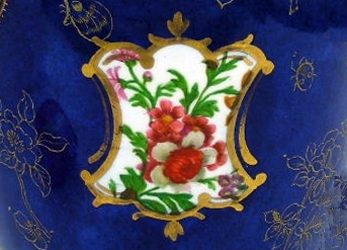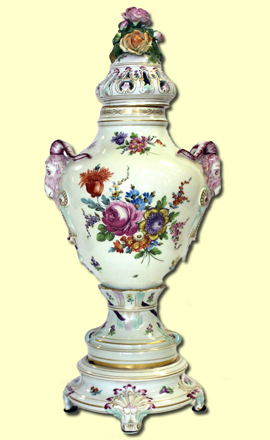
DRESDEN 2033 pattern.
12 February 2015. Expanded & edited February 2023.
Carlton Ware's pattern records tell us that one of the earliest designs by Horace Wain, circa 1913, was named DRESDEN.
It gave the illusion of being an elaborate pattern in the rococo style, employing decorating techniques, most notably a Powder Blue ground, as used by Wain's former employers. At the beginning of the 20th century this ground colour had become fashionable again. On the right is a detail from the pattern, showing one of the reserves. Notice the gold printed insects, foliage and flowers on the blue background.
DRESDEN springs to mind today because the city is in the news.

Middle - Allied forces firebombing Dresden in 1945.
Bottom - Dresden after the destruction.
Seventy years ago this week, the architectural gem, in the East of Germany, close to the Czech Republic, was heavily firebombed by the Allies.
It was at Dresden in 1709 that European porcelain was formulated. Many artists, who previously had been attracted to the royal capital, began to decorate the new ceramic in highly skilful ways.
Dresden, and indeed the nearby town of Meissen, is associated with the rococo style of porcelain characterized by a profusion of flowers, foliage, fruits, shells and scrolls, not only in pattern, but also in shape, as in the example below.


Notice that the shapes are Chinese in origin.
Wain was also fond of the work of other long established porcelain and china manufacturers such as Worcester, Swansea, Lowestoft and Crown Derby.
Wain, however, is being innovative by experimenting with relatively new decorating techniques. Here he employs a slide on chromo-lithograph combining it with freehand painting and gilding. Chromo-lithographs were a recent introduction in the Staffordshire potteries. Wain will have known the suppliers of the chromo-lithograph, and may have been asked by them to see what he could achieve with the newly introduced transfer decorations. The slide on transfers might have been of German origin, though locally there were an increasing number of specialist lithographic printers set up to supply the pottery industry.

in 1935 and as a stylized version of a typical Dresden motif.
Notice the compositional similarity with Horace Wain's traditional copy.
In 1935, some twenty or so years later, Susie Cooper pays her tribute to Dresden with a pattern of the same name, also using a chromo-lithograph, which had much improved. To the untrained eye it is very hard to tell that the decoration is not freehand painted.
Minton, Doulton and Crown Staffordshire also used the Dresden name and no doubt many others potteries. ❑
So highly regarded was the work carried out in Dresden that in the nineteenth century, a southern district of Stoke-on-Trent was named after the German city. ❑
© Harvey Pettit 2015. Expanded & edited 2023.
